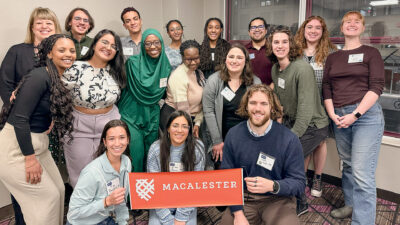
As senior product manager at Salesforce, Chelsey Smith ’06 works at the intersection of customer, technology, and business. “Product is at the table to represent the voice of the customer,” she says. “We focus on the heart of what a customer is trying to do.” The product team she is a part of generates ideas on what features to build (and why), prioritizes what to build first, and then collaborates with designers, engineers, and others to execute. Smith’s perspective is informed by her degree in studio arts from Mac, a graduate degree in architecture, and past roles as an architect and small-business owner. Here she reflects on some of the pivots she’s made so far, and the lessons she’s learned along the way.
Doing is not the same as creating value
I used to be a zero-inbox person. That was my sign that I’m doing my job, and I’m great at it. The last few years I’ve had to become more intentional about how I use my time and what I’m doing. My natural place is to jump in and just start. Now I recognize that doing is not the same as creating value. I’ve let go of things—I’m not a zero-inbox person anymore. That’s something that was freeing, and I think I do more valuable work in exchange.
Be 5 percent more human
At Salesforce we embrace bringing your whole, authentic self to work. I struggled with that for a while. I was friendly enough but transactional. I felt like, “We’re at work. Let’s get work done.” Now I think that even if it’s just a 5 percent increase in that area, just showing folks a little of your vulnerable and human side can put some people at ease.
Normalize not knowing
I have a phrase on my whiteboard that reads, “normalize not knowing.” It’s OK to say, “I don’t know.” I’m an internal processor, and I’m not good on the spot. I have tried to embrace that and say, “I’ve never thought about it that way. Let me get back to you.” I would much rather take a beat to think when I need to offer a solution.
Ask yourself, ‘Is this irreversible?’
A few years ago, I decided to leave my salaried day job and start a small business. That ran its course for a couple years, but I eventually came back to the same company—Salesforce—in a different role and as a more seasoned person. Things are different, but it wasn’t an irreversible decision. Giving yourself a little bit of grace to say, “If I make the less-than-great decision or get some new information in the future, do I have the room to change my mind or change the direction?” is something I wish I had embraced earlier on.
See your skills in a new light
I pivoted from architecture into all things digital by leaning on skills I had in the organization space. My then boyfriend (now husband) and I were living in Seattle and he encouraged me to explore roles in digital. I honed in on project management and did a bunch of cold outreach. I started project managing website redesigns and website development, and apps came a little bit later. I love the scale, and speed, and opportunities to reach a big audience and interact with them.
Know your worth
I hope everyone finds themselves with good managers and people-leaders, but you need to advocate for yourself and ask for those stretch goals, ask for the pay you need, the space you need, the time you need—whatever it may be. People have great intentions and they want to help you be successful, but they don’t always know how to do that or know what you need.
July 18 2023
Back to top





